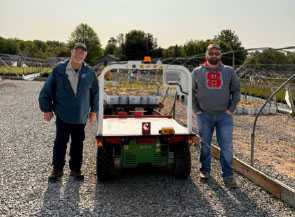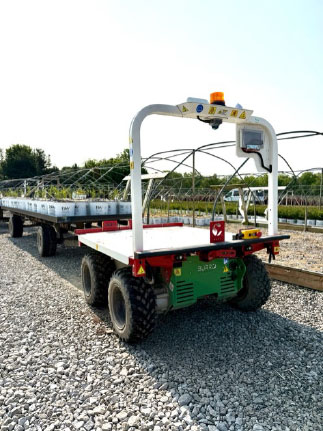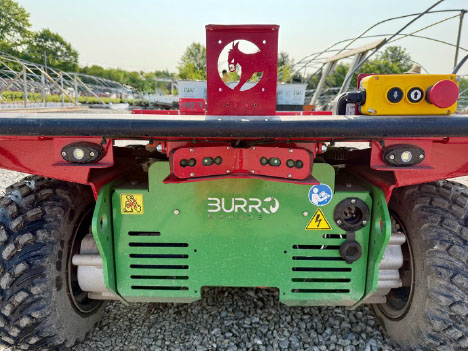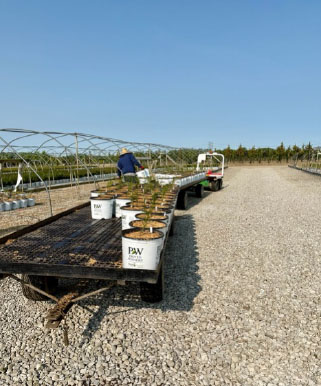Willoway’s Secret to Moving 36,000 Hydrangeas? Six Driverless Burros
You might find yourself doing a double take at Willoway Nurseries in Avon, Ohio, where self-driving vehicles are the new norm.
Spread across 1,000 acres, the operation recently deployed six autonomous tractors from a Philly-based company called Burro, and their impact on efficiency has been immediate.The Burros arrived in spring and are already proving to be reliable haulers in the nursery’s canning process, delivering newly potted plant material to designated drop-off points.  “We got a fleet of six of them back in March,” said Willoway’s Staff Horticulturist – R&D, Ben Averitt. “We’ve mostly been using them for our canning process, for delivering newly canned material to the set downs.” Each unit runs on preprogrammed routes built from drone-generated maps and custom overlays. It’s a setup that takes time to establish, but once in place, the system becomes intuitive. “It’s a slow process, but then once you have it all drawn, you punch in the location you want it to go to and it finds the best route to get there based on the information it has,” Averitt explained.
“We got a fleet of six of them back in March,” said Willoway’s Staff Horticulturist – R&D, Ben Averitt. “We’ve mostly been using them for our canning process, for delivering newly canned material to the set downs.” Each unit runs on preprogrammed routes built from drone-generated maps and custom overlays. It’s a setup that takes time to establish, but once in place, the system becomes intuitive. “It’s a slow process, but then once you have it all drawn, you punch in the location you want it to go to and it finds the best route to get there based on the information it has,” Averitt explained.
 For light loads, speed is intentionally limited to about 2.5 miles per hour to prevent plants from jostling off tractor beds during transport. Still, even at that speed, the Burros are making a difference. “It’s saving us a body moving back and forth on a tractor,” Averitt noted. The labor efficiency afforded by the Burros has been massive. Add in a forklift for unloading and “now we’ve taken a four-guy process down to one guy,” said Averitt. The other three workers, now freed up from repetitive driving, are deployed to higher-value nursery work like trimming, spacing, and fertilizing. Besides their efficiency, the Burros are clever and surprisingly interactive. Outfitted with sensors, they can detect obstacles within six feet, stop at intersections, and emit a short honk as a safety measure.
For light loads, speed is intentionally limited to about 2.5 miles per hour to prevent plants from jostling off tractor beds during transport. Still, even at that speed, the Burros are making a difference. “It’s saving us a body moving back and forth on a tractor,” Averitt noted. The labor efficiency afforded by the Burros has been massive. Add in a forklift for unloading and “now we’ve taken a four-guy process down to one guy,” said Averitt. The other three workers, now freed up from repetitive driving, are deployed to higher-value nursery work like trimming, spacing, and fertilizing. Besides their efficiency, the Burros are clever and surprisingly interactive. Outfitted with sensors, they can detect obstacles within six feet, stop at intersections, and emit a short honk as a safety measure.  They can also follow a worker around the nursery, a feature Averitt likened to “a little puppy dog.” Currently, each unit must be manually started every morning, but updates are on the horizon. An autonomous docking station is in development, which will allow the Burros to charge themselves overnight and begin work on a preset schedule. “We’ll be able to home, dock, plug in, and then [it can] unplug itself. Say, six o’clock in the morning, you want it up and running, and bam, there it is,” Averitt said.
They can also follow a worker around the nursery, a feature Averitt likened to “a little puppy dog.” Currently, each unit must be manually started every morning, but updates are on the horizon. An autonomous docking station is in development, which will allow the Burros to charge themselves overnight and begin work on a preset schedule. “We’ll be able to home, dock, plug in, and then [it can] unplug itself. Say, six o’clock in the morning, you want it up and running, and bam, there it is,” Averitt said.
In terms of strength, the Burro Grande is rated to tow up to 5,000 pounds, though the Willoway team has tested it with loads up to 9,000 pounds with no complaints. Recently during a large contract order, the Burros moved 36,000 hydrangeas with remarkable speed and consistency. “We set up a superhighway for them,” Averitt said. “It was a slick setup.” The company is already planning further tech integrations. RFID tagging is being explored for real-time inventory mapping, and one of the Burros will soon be fitted with a mower. There’s also potential to attach sensors for thermal mapping and monitoring heaters in the winter. Willoway is one of the first nurseries in the country to use this technology, receiving the hundredth Burro ever produced.
 Their property is also the largest operation the machines have been deployed on to date. Willoway’s early adoption and expansive footprint has made it a pioneer in the industry, a case study for integrating automation. Learning to use the Burros has been relatively easy. Averitt estimated that most staff are up and running with the system in about two hours. One of the company’s H-2A workers has become the in-house expert, regularly updating maps on his phone and helping others navigate the system. As with any new tool, there’s been a cultural adjustment. Averitt laughed when recalling some of the early reactions. “One of our biggest issues was that people wanted to pet them,” he said.
Their property is also the largest operation the machines have been deployed on to date. Willoway’s early adoption and expansive footprint has made it a pioneer in the industry, a case study for integrating automation. Learning to use the Burros has been relatively easy. Averitt estimated that most staff are up and running with the system in about two hours. One of the company’s H-2A workers has become the in-house expert, regularly updating maps on his phone and helping others navigate the system. As with any new tool, there’s been a cultural adjustment. Averitt laughed when recalling some of the early reactions. “One of our biggest issues was that people wanted to pet them,” he said.  “There’s a lot of jokes about who’s the real burro—the machine or the guys. ” Jokes aside, the benefit is clear. “When these things are working, which is 90% of the time, they’re awesome,” Averitt said. “We can cook with peanut oil with these things.”
“There’s a lot of jokes about who’s the real burro—the machine or the guys. ” Jokes aside, the benefit is clear. “When these things are working, which is 90% of the time, they’re awesome,” Averitt said. “We can cook with peanut oil with these things.”
Automation isn’t replacing workers at Willoway, it’s allowing them to do more specialized tasks. And on a 1,000-acre nursery with no time to waste, that kind of ROI speaks for itself. “The whole goal is to take out the mindless work,” Averitt said. “What these guys are really good at is their job. Why have to drive a tractor?”
Visit Willoway Nurseries and learn more about their new burro buddies!
Tags: automation, burros, nursery